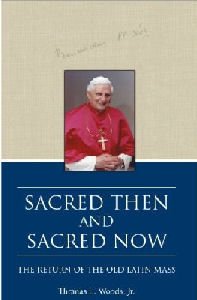
|
Posted June 29, 2008
Book: Sacred Then and Sacred Now: The Return of the Old Latin Mass Author: Thomas E. Woods, Jr. Roman Catholic Books. Fort Collins, CO. 2008. Pp. 120 An Excerpt from the Jacket:
Fr. Kenneth Baker, S.J., Editor, Homiletic and Pastoral Review An Excerpt from the Book: What, then, were Ratzinger’s main criticisms? First, he contended that the new missal gave rise to excessive creativity in liturgical celebration, which in turn underminded the very essence of liturgy and cut Catholics off not only from their past but even from the parish down the street, where Mass was celebrated differently . . . . “To most people the liturgy seems to be rather something for the individual congregation to arrange. Core groups make up their own ‘liturgies’ from week to week, with an enthusiasm which is as amazing as it is misplaced.” . . . A second major theme in Ratzinger’s corpus of liturgical writing is what he called desacralization. He told the Chilean bishops in 1988 that although many reasons could be cited to explain why a great many people “seek refuge in the traditional liturgy,” the primary one was that “they find the dignity of the sacred preserved there.” After the Council, he explained, many priests “deliberately raised ‘desacralization’ to the level of a program.” They argued that the New Testament had abolished the cult of the Temple, and that the tearing of the veil of the Temple from top to bottom upon Christ’ death was meant to signify the end of the sacred. “The death of Jesus, outside the City walls, that is to say, in the public world, is now the true religion. Religion, if it has any being at all, must have it in the nonsacredness of daily life . . . Inspired by such reasoning, they put aside the sacred vestments; they have despoiled the churches as much as they could of that splendor which brings to mind the sacred; and they have reduced the liturgy to the language and the gestures of ordinary life, by means of greetings, common signs of friendship, and such things.” . . . Ratzinger’s third major criticism of the liturgical reform was that whatever its virtues, the new missal, both in particular sections and in its entirety, leaves the impression of a rupture with the past, and in some ways seems contrived. It resembles more a compilation by a committee of professors than the organic development of a truly living liturgy. “In the place of liturgy as the fruit of development came fabricated liturgy,” Ratzinger wrote. “We abandoned the organic, living process of growth and development over centuries, and replaced it — as in a manufacturing process — with a fabrication, a banal on-the-spot product.” . . . Again Ratzinger faulted the new liturgical books themselves, not merely their clumsy implementation. “Even the official new books, which are excellent in many ways, occasionally show far too many signs of being drawn up by academics and reinforce the notion that a liturgical book can be ‘made’ like any other book.” The new missal, “was published as if it were a book put together by professors, not a phase in a continual growth process. Such a thing never happened before. It is absolutely contrary to the laws of liturgical growth.” Ratzinger cited the reform of the liturgical calendar as an example of “the armchair strategy of academics, drawing up things on paper which, in fact, would presuppose years of organic growth.” This approach was “one of the weaknesses of the psotconciliar liturgical reform.” Those responsible, he said, simply “did not realize how much the various annual feasts had influenced Christian people’s relation to time. In redistributing these established feasts throughout the year according to some historical arithmetic — inconsistently applied at that — they ignored a fundamental law of religious life.” Table of Contents: 1. Why Benedict restored the classical liturgy 2. Benedict’s revolution 3. A brief guide to the extraordinary form 4. Important features of the extraordinary form 5. Common misconceptions Appendix A: Pope Benedict XVI’s letter to bishops, July 7, 2007. Appendix B: The motu proprio Summorum Pontificum Appendix C: Useful resources Appendix D: Sermon of Father Calvin Goodwin, FSSP About the author |
|
